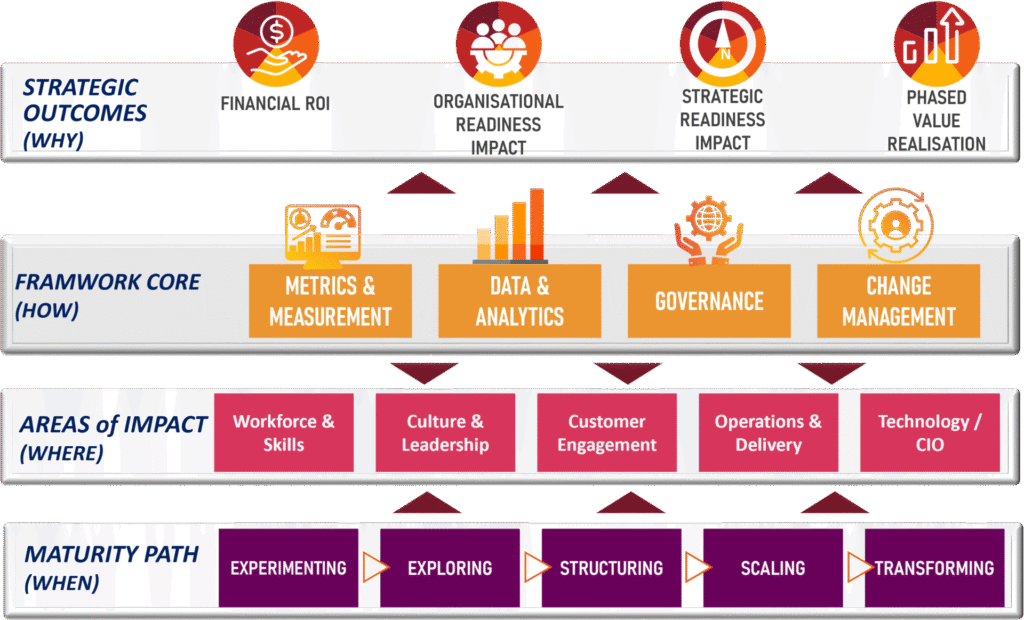AI Workforce Disruption: How Leaders Can Measure Readiness and Build Strategy
The Urgency of AI Workforce Disruption
AI workforce disruption is happening now as we write. Companies are tripping over each other trying to roll out GenAI in content creation, customer interaction, and data analysis. The technology is moving faster than most organizations can adjust their workforce strategies. This gap between technology and workforce strategies is the gap where the risk lies.
Most leaders still view AI in terms of pilots, point solutions and efficiency gains. They measure cost savings and productivity while overlooking the workforce impact. Which roles are changing? What skills will be needed? How should people be redeployed? Without clear tactics and metrics, leaders are navigating this shift without instruments.
Job Impact in Action: Content writing as a Signal Case
Consider content writing as an example. As a profession, today, it offers a clear view of what disruption looks like in practice. Until recently, copywriting was considered safe from automation because it draws on creativity and nuance. However, GenAI tools now understand brand and product positioning and use that knowledge to draft ads, write copy, create blog posts, scripts, and campaign copy at scale. The quality may isn’t perfect yet, but is often good enough for the volume-driven work that makes up much of the industry.
For copywriters, for instance, this changes the job itself. Basic drafting can be automated, leaving a smaller space for refinement and creative direction. Openings for entry-level writers are fast drying up. The signal is unmistakable: even creative roles can be reshaped when tasks are repetitive and rules-driven.
This is not just about copy or content writing or even programming. The same forces will reach legal research, market analysis, compliance, and other fields where large parts of the work can be broken down into patterns. Copy or content writing are simply the early warning professions. Leaders who see it as one-off risks are missing the bigger picture.
The Broader Risk Landscape: Which Jobs Are Vulnerable?
AI can’t possibly eliminate entire job families overnight. It is, however, changing the mix of tasks within them. Jobs that are routine-heavy, content-driven, or based on repeatable rules are most exposed. These include roles in customer service, data entry, content production, and parts of finance and large swathes of (today’s) HR.
On the other side are roles that depend on judgment, context, and relationships. Negotiating a complex deal, guiding a team through change, or designing a product strategy cannot be reduced to pattern-matching. These jobs will still change, but they are more likely to be augmented than replaced.
The uneven impact creates a leadership challenge. You cannot classify entire functions as “safe” or “at risk.” You have to look at the task level and plan accordingly. That requires a way to measure exposure, readiness, and options for redeployment. Without these measurement mechanisms, companies will fall back on blunt measures e.g. job cuts, hiring freezes, thus creating more problems than they solve.

The Leadership Blind Spot: No Metrics, No Strategy
This is, we believe, the core problem. Leaders are deploying AI without a measurement system for workforce impact. They can tell you how much money a chatbot saves on customer calls but not how prepared their staff are to take on new roles. They know how many hours a drafting tool reduces in legal research but not whether their culture can absorb a shift in job design.
The result is reactive management, at best. Disruption hits, and the response is often layoffs or rushed reskilling programs. Employees feel blindsided, trust erodes, and the organization loses momentum. The costs are hidden but real: talent flight, brand damage, or even missed opportunities to create value through better workforce design.
Without metrics, there is no strategy. And without strategy, AI workforce disruption becomes a liability instead of an advantage.
The KPI Framework: Measuring and Managing AI Workforce Disruption
What organizations need is a structured way to measure. A KPI framework built (e.g. 3nayan ‘s AI KPI framework) for AI adoption can close the gap. It shifts the conversation from anecdotes and pilot projects to data-driven readiness and phased execution.

The framework rests on four dimensions:
- Financial ROI: Direct savings and efficiency gains from AI initiatives.
- Organizational Readiness Impact: The preparedness of workforce, culture, and governance to adopt AI.
- Strategic Positioning Impact: The degree to which AI strengthens long-term competitiveness and relevance.
- Phased Value Realization: Tracking benefits over time, across adoption, reskilling, and redeployment.
Consider an example, say, production support for IT. A company deploying AI chatbots can measure more than reduced handling time. It can assess how ready the workforce is for retraining, whether redeployment opportunities exist, and how customer satisfaction trends alongside automation. In doing so, it avoids the trap of chasing short-term savings at the expense of long-term capability.
This approach creates a common language between executives, HR leaders, and technology teams. It turns AI from a series of experiments into a managed transformation. It also allows leaders to answer the hardest questions with evidence: What jobs are changing? How do we prepare? Where does new value come from?
From Disruption to Readiness
Just talking about AI workforce disruption is no more than admiring the problem. That too from a distance. It is a management challenge that demands a structured response. Companies that measure only financial ROI will struggle to build resilience. Companies that measure readiness, positioning, and phased value will move faster and steadier.
The difference, finally, comes down to relevant and fit for purpose metrics. Without them, leaders react after the fact. With them, they can guide their organizations through disruption with clarity.
AI will not slow down. Leaders cannot afford to either. The companies treat AI workforce disruption not just as a problem, but as an opportunity to redesign work, reskill talent, and create value for the long term, will WIN.